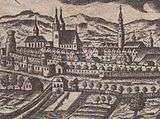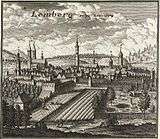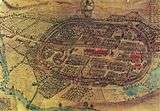Lwówek Śląski
| Lwówek Śląski | |||
|---|---|---|---|
|
The town hall, The Church of the Assumption of the Blessed Virgin Mary, the municipal office, The Lubań Tower, The Płakowice Palace, the tenements in the town centre | |||
| |||
 Lwówek Śląski | |||
| Coordinates: 51°7′N 15°35′E / 51.117°N 15.583°E | |||
| Country |
| ||
| Voivodeship | Lower Silesian | ||
| County | Lwówek Śląski County | ||
| Gmina | Gmina Lwówek Śląski | ||
| Established | before 1209 | ||
| Town rights | 1217 | ||
| Government | |||
| • Mayor | Mariola Szczęsna | ||
| Area | |||
| • Total | 16.65 km2 (6.43 sq mi) | ||
| Population (2006) | |||
| • Total | 9,687 | ||
| • Density | 580/km2 (1,500/sq mi) | ||
| Time zone | CET (UTC+1) | ||
| • Summer (DST) | CEST (UTC+2) | ||
| Postal code | 59-600 | ||
| Area code(s) | +48 75 | ||
| Car plates | DLW | ||
| Climate | Dfb | ||
| Website | http://www.lwowekslaski.pl | ||
Lwówek Śląski [ˈlvuvɛk ˈɕlɔ̃skʲi] (Polish: Lwówek Śląski (![]() listen); German: Löwenberg in Schlesien) is a town in the Lower Silesian Voivodeship in Poland. Situated on the Bóbr River, Lwówek Śląski is about 30 kilometres (19 miles) NNW of Jelenia Góra and has a population of about 10,300 inhabitants. It is the administrative seat of Lwówek Śląski County, and also of the smaller municipality called Gmina Lwówek Śląski.
listen); German: Löwenberg in Schlesien) is a town in the Lower Silesian Voivodeship in Poland. Situated on the Bóbr River, Lwówek Śląski is about 30 kilometres (19 miles) NNW of Jelenia Góra and has a population of about 10,300 inhabitants. It is the administrative seat of Lwówek Śląski County, and also of the smaller municipality called Gmina Lwówek Śląski.
History
The vicinity of Lwówek Śląski, densely wooded and located on the inner side of the unsettled[1] Silesian Przesieka,[2] was gradually cleared and populated by German peasants in the first half of the 13th century during the Ostsiedlung.[3] The town was founded by Duke of Poland Henry the Bearded who designated it for an administrative centre in a previously uninhabited, borderline Polish - Lusatian territory.[4] By 1217 the settlement, founded by the Duke of Wrocław, had important privileges, such as rights to brew, mill, fish, and hunt within a mile from settlement. German colonists expanded[5] upon the preexisting settlement and in 1217 it received town rights as the second town in Silesia; its style of governance was duplicated by other local towns, such as Bunzlau (Bolesławiec), as Löwenberg Rights or Lwówek Śląski Rights.[6] The dukes then constructed a castle, documented for the first time in 1248. In the second half of the 13th century Löwenberg became the capital of a Silesian Piast principality, whose duke took the title of a Duke of Silesia and Lord of Löwenberg.
| The prints of Lwówek Śląski during the centuries | ||||||||
|---|---|---|---|---|---|---|---|---|
|
After the death of Duchess Agnes of Habsburg, the widow of Bolko II, the last Piast of Świdnica, the region was inherited with the Duchy of Świdnica-Jawor (Schweidnitz-Jauer) by the Kingdom of Bohemia in 1393. Löwenberg's placement on a trade route allowed it to become one of the more prosperous towns in Bohemia. It passed with the Bohemian crown to the Habsburg Monarchy of Austria in 1526. During the Thirty Years' War, Löwenberg was devastated by Swedish and Imperial troops, especially between 1633-1643. By the Peace of Westphalia in 1648, the town was largely destroyed and had a decimated population of only hundreds.
Löwenberg slowly recovered during its reconstruction, but began to prosper again after its acquisition by the Kingdom of Prussia in 1741 during the Silesian Wars. Troops of the First French Empire occupied Löwenberg in May 1813, and Napoleon Bonaparte stayed in the town from August 21–23 while organizing his defenses against the Prussian troops of General Gebhard von Blücher. A few days later the Prussian army defeated the Frenchmen; more than 3,000 French soldiers drowned in the flooding Bober (Bóbr) as they retreated.
Löwenberg was included within the Province of Silesia after the 1814 Prussian administrative reorganization. Like the rest of the Kingdom of Prussia, the town became part of the German Empire in 1871 during the unification of Germany. It became part of the Prussian Province of Lower Silesia after World War I.
In the last days of World War II, Löwenberg's medieval center was 40% destroyed and numerous buildings of Gothic, Renaissance, and Baroque were lost. At war's end the town was placed under Polish administration as Lwówek Śląski according to the Potsdam Agreement. Its remaining German population was expelled and replaced with Poles.
Coat of arms
The coat of arms of Lwówek Śląski is a vertically divided shield depicting the red-white chessboard of the Świdnica Piasts in the sinister field and a right-facing crowned red lion in the dexter field.
Population
| Year | 1329 | 1543 | 1740 | 1784 | 1797 | 1816 | 1825 | 1840 | 1861 | 1871 | 1885 | 1905 |
|---|---|---|---|---|---|---|---|---|---|---|---|---|
| Population number[7] | ok. 11.000 | 4.100 | 1.495 | 2.397 | 3.928 | 3.684 | 3.552 | 3.770 | 4.628 | 4.798 | 4.720 | 5.682 |
| Year | 1920 | 1941 | 1945 | 1950 | 1960 | 1970 | 1978 | 1988 | 1999 | 2000 | 2006 | 2016 |
| Population number | 6.319 | 6.063 | 6.238 | 3.411 | 5.517 | 6.714 | 7.776 | 9.312 | 9.249 | 10.045 | 9.687 | 8940 |
- Graph of population of the city of Lwówek Śląski, over the last 2 centuries:
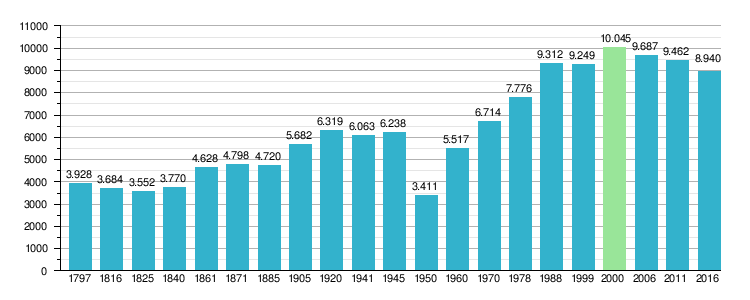
Climate
| Climate data for Lwówek Śląski (1979–2013) | |||||||||||||
|---|---|---|---|---|---|---|---|---|---|---|---|---|---|
| Month | Jan | Feb | Mar | Apr | May | Jun | Jul | Aug | Sep | Oct | Nov | Dec | Year |
| Record high °C (°F) | 14.5 (58.1) |
16.3 (61.3) |
20.4 (68.7) |
28.4 (83.1) |
30.2 (86.4) |
34.2 (93.6) |
35.9 (96.6) |
35.9 (96.6) |
28.5 (83.3) |
25.1 (77.2) |
17.2 (63) |
13.3 (55.9) |
35,9 (96.6) |
| Average high °C (°F) | 1.3 (34.3) |
2.7 (36.9) |
7.4 (45.3) |
13.3 (55.9) |
18.7 (65.7) |
21.3 (70.3) |
23.4 (74.1) |
23.3 (73.9) |
18.3 (64.9) |
13.0 (55.4) |
6.3 (43.3) |
2.6 (36.7) |
12,6 (54.72) |
| Average low °C (°F) | −4.1 (24.6) |
−3.6 (25.5) |
−0.4 (31.3) |
3 (37) |
7.4 (45.3) |
10.6 (51.1) |
12.4 (54.3) |
12.0 (53.6) |
8.7 (47.7) |
4.8 (40.6) |
0.8 (33.4) |
−2.4 (27.7) |
4,1 (39.34) |
| Record low °C (°F) | −26.3 (−15.3) |
−23.9 (−11) |
−14.6 (5.7) |
−6.9 (19.6) |
−2.9 (26.8) |
1.3 (34.3) |
5.1 (41.2) |
3.9 (39) |
−0.1 (31.8) |
−6.0 (21.2) |
−13.5 (7.7) |
−22.9 (−9.2) |
-26,3 (−15.3) |
| Average precipitation mm (inches) | 43 (1.69) |
36 (1.42) |
44 (1.73) |
36 (1.42) |
53 (2.09) |
66 (2.6) |
90 (3.54) |
75 (2.95) |
52 (2.05) |
37 (1.46) |
44 (1.73) |
48 (1.89) |
623 (24.53) |
| Average precipitation days (≥ 1.0 mm) | 12 | 10 | 11 | 8 | 10 | 12 | 12 | 11 | 10 | 8 | 10 | 12 | 126 |
| Source: http://eca.knmi.nl/ | |||||||||||||
Culture and entertainment
Lwówek's Culture Centre
Lwówek's Culture Centre is located in Przyjaciół Żołnierza St. 5. In town's culture centre there are:
- Cinema LOK;
- Office of providers the cable TV;
- Art gallery Kla-Tka;
- Dance School Vega;
- Music room;
- School of painting and drawing.
City events


Every year in the second weekend of July takes place Lwóweckie Lato Agatowe.
- In January – The Kings Parade in the Feast of Three Kings(06.01);
- In March –Lwówek talent fest;
- In April – Nationwide Orientation Fest (III round of Polish Cup);
- In May – International canoeing trip on the Bóbr river;
- In May – Turist rally name Henryk the Bearded;
- In July – Lwówek Agat Summer;
- In July – Lwówek motocycle jumboree;
- In September – Unusual Heritage Fairs - Napoleonic Picknic, Lower Silesian Festival Of Gifts Of The Forest ;
- In October – Lwówek Mineralogical Meeting;
- In December – Christmas Fair, Santa Claus Run, Christmas nativity play.
Museums
In Lwówek Śląski there are two important museums:
- Museum - historical facility in the town hall (Wolności Sq. 1);
- Museum of the Brewery in the town brewery "Lwówek" (Traugutta St. 4).
In the second weekend of July, when Lwówek Agat Summer lasts, you can also visit Lubańska Tower and admire the great, breathtaking view on the town.
Twin cities

| Town | Country | The date of the beginning of partnership |
|---|---|---|
| 2003[8] | ||
| 4 April 1995 | ||
| 16 November 2000 | ||
| 21 June 2006 | ||
| 18 June 2007[9] | ||
| 22 September 2009 |
Notable residents
- Nikolaus von Reusner (1545–1602), jurist
- Martin Moller (1547–1606), mystic
- Michael Wirth (1571–1618), jurist
- Georg Schultze (1599–1634), jurist
- Esaias Reusner (1636–1679), lutist and composer
- Franz Schmidt (1818–1853), preacher, representative in the Frankfurt Parliament in 1848, fled to Switzerland, then to St. Louis, MO, USA; founder of the German Lyceum there.
- Günther Klammt (1898–1971), major-general
- Eberhard Zwirner (1899–1984), physician and phonetician
- Stefan Hüfner (born 1935), physicist
- Lucjan Błaszczyk (born 1974), tennis player
Skylines
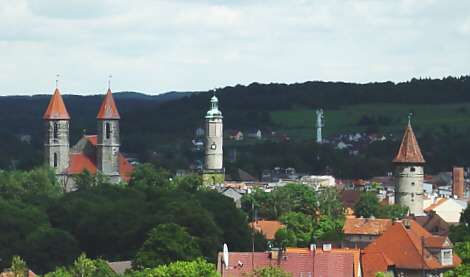
Notes
- ↑ Petry, Ludwig; Geschichte Schlesiens. Band 1: Von der Urzeit bis zum Jahre 1526, Stuttgart, Jan Thorbecke Verlag, 2000, p.11, ISBN 3-7995-6341-5
- ↑ Hugo Weczerka, Handbuch der historischen Stätten, Schlesien, 2003, p.296, ISBN 3-520-31602-1
- ↑ Westermann, p. 74
- ↑ Jerzy Maroń, Legnica 1241 Historyczne Bitwy, Bellona 2008, p. 44, ISBN 83-11-11171-5
- ↑ Krallert, "Die nord- und mitteldeutsche Ostsiedlung vom 12.—14. Jahrhundert"
- ↑ Krallert, "Die Ausbreitung des deutschen Städtewesens bis 1400"
- ↑ Staffa, Marek (2003). Słownik geografii turystycznej Sudetów, Pogórze Izerskie. [1], A-Ł [Glossary tourist geography of the Sudetenland, Foothills Mountains. [1] A-L]. Wroclaw: I-BiS. pp. 443–471. ISBN 83-85773-60-6.
- ↑ "miasta partnerskie" (PDF).
- ↑ "Chrastava - polski". www.chrastava.cz. Retrieved 2015-08-10.
References
- Westermann Verlag; Erich Stier; Ernst Kirsten; Wilhelm Wühr; Heinz Quirin; Werner Trillmilch; Gerhard Czybulka; Hermann Pinnow; Hans Ebeling (1963). Westermanns Atlas zur Weltgeschichte: Vorzeit / Altertum, Mittelalter, Neuzeit (in German). Braunschweig: Georg Westermann Verlag. p. 170.
- Krallert, Wolfgang (1958). Atlas zur Geschichte der deutschen Ostsiedlung. Bielefeld: Velhagen & Klasing. p. 33.
External links
| Wikimedia Commons has media related to Lwówek Śląski. |
| Wikisource has the text of the 1911 Encyclopædia Britannica article Löwenberg. |
- Municipal website (in Polish)
Coordinates: 51°07′N 15°35′E / 51.117°N 15.583°E



